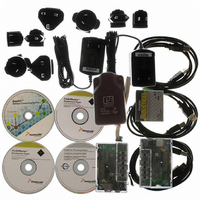1321XDSK-BDM Freescale Semiconductor, 1321XDSK-BDM Datasheet - Page 22

1321XDSK-BDM
Manufacturer Part Number
1321XDSK-BDM
Description
KIT STARTER DEV 1321X W/USB
Manufacturer
Freescale Semiconductor
Type
Sensor Demor
Specifications of 1321XDSK-BDM
Frequency
2.4GHz
Wireless Frequency
2.4 GHz
Interface Type
SPI
Modulation
DSSS OQPSK
Security
128 bit AES
Operating Voltage
2 VDC to 3.4 VDC
Output Power
2 dBm
Antenna
F-Antenna
Operating Temperature Range
- 40 C to + 85 C
For Use With/related Products
MC1321x
Lead Free Status / RoHS Status
Contains lead / RoHS compliant by exemption
4.7
The modem crystal oscillator uses the following external pins as shown in
The 802.15.4 Standard requires that several frequency tolerances be kept within ± 40 ppm accuracy. This
means that a total offset up to 80 ppm between transmitter and receiver will still result in acceptable
performance. The primary determining factor in meeting the 802.15.4 Standard is the tolerance of the
crystal oscillator reference frequency. A number of factors can contribute to this tolerance and a crystal
specification will quantify each of them:
Freescale has specified that a 16 MHz crystal with a <9 pF load capacitance is required. The 802.15.4
modem does not contain a reference divider, so 16 MHz is the only frequency that can be used. A crystal
requiring higher load capacitance is prohibited because a higher load on the amplifier circuit may
compromise its performance. The crystal manufacturer defines the load capacitance as that total external
capacitance seen across the two terminals of the crystal. The oscillator amplifier configuration used in the
802.15.4 modem requires two balanced load capacitors from each terminal of the crystal to ground. As
such, the capacitors are seen to be in series by the crystal, so each must be <18 pF for proper loading.
The modem uses the 16 MHz crystal oscillator as the reference oscillator for the system and a
programmable warp capability is provided. It is controlled by programming CLKO_Ctl Register 0A, Bits
22
1. XTAL1 - reference oscillator input.
2. XTAL2 - reference oscillator output. Note that this pin should not be loaded as a reference source
1. The initial (or make) tolerance of the crystal resonant frequency itself.
2. The variation of the crystal resonant frequency with temperature.
3. The variation of the crystal resonant frequency with time, also commonly known as aging.
4. The variation of the crystal resonant frequency with load capacitance, also commonly known as
or to measure frequency; instead use CLKO to measure or supply 16 MHz.
pulling. This is affected by:
a) The external load capacitor values - initial tolerance and variation with temperature
b) The internal trim capacitor values - initial tolerance and variation with temperature
c) Stray capacitance on the crystal pin nodes - including stray on-chip capacitance, stray package
Modem Crystal Oscillator
capacitance and stray board capacitance; and its initial tolerance and variation with temperature
MC13211/212/213 Technical Data, Rev. 1.8
Figure 12. Modem Crystal Oscillator
27
XTAL1
MC1321X
16MHz
802.15.4 MODEM
28
XTAL2
10
CLKO
Figure
12.
Freescale Semiconductor











